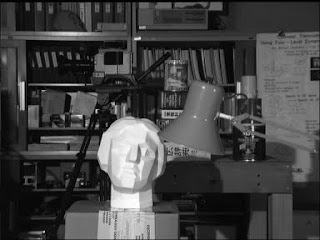The stereo pair is represented by two input images, these images are taken with two cameras separated by a distance and the disparity map is derived from the offset of the objects between them. There are various algorithm to compute a disparity map, the one implemented in OpenCV is the graph cut algorithm. To use it we have to call the function CreateStereoGCState() to initialize the data structure needed by the algorithm and use the function FindStereoCorrespondenceGC() to get the disparity map. Let's see the code:
def cut(disparity, image, threshold):
for i in range(0, image.height):
for j in range(0, image.width):
# keep closer object
if cv.GetReal2D(disparity,i,j) > threshold:
cv.Set2D(disparity,i,j,cv.Get2D(image,i,j))
# loading the stereo pair
left = cv.LoadImage('scene_l.bmp',cv.CV_LOAD_IMAGE_GRAYSCALE)
right = cv.LoadImage('scene_r.bmp',cv.CV_LOAD_IMAGE_GRAYSCALE)
disparity_left = cv.CreateMat(left.height, left.width, cv.CV_16S)
disparity_right = cv.CreateMat(left.height, left.width, cv.CV_16S)
# data structure initialization
state = cv.CreateStereoGCState(16,2)
# running the graph-cut algorithm
cv.FindStereoCorrespondenceGC(left,right,
disparity_left,disparity_right,state)
disp_left_visual = cv.CreateMat(left.height, left.width, cv.CV_8U)
cv.ConvertScale( disparity_left, disp_left_visual, -16 );
cv.Save( "disparity.pgm", disp_left_visual ); # save the map
# cutting the object farthest of a threshold (120)
cut(disp_left_visual,left,120)
cv.NamedWindow('Disparity map', cv.CV_WINDOW_AUTOSIZE)
cv.ShowImage('Disparity map', disp_left_visual)
cv.WaitKey()
These are the two input image I used to test the program (respectively left and right):
Result using threshold = 100
Result using threshold = 120
Result using threshold = 180






Thanks for the disparity map code.
ReplyDeleteDo you know of any pythonese version of the full stereo calibration, etc. code from the Learning OpenCV book? I'm surprised that no one has posted this already. Please let me know if anyone has a version to share: samador@haverford.edu
Why do you scale the 16 bit signed disparity image with factor -20:
ReplyDeletecv.ConvertScale( disparity_left, disp_left_visual, -20 );
I think you should scale it with -16 into an 8 bit, shouldn't you?
With best regards,
Marc
Hello Mark, thanks for your comment.
ReplyDeleteIt's a mistake. As you noticed, the correct scaling factor is -16.
bests
very good tutorial for stereo vision with a powerful vision software like Opencv. I add a link of your article to my post about stereo vision systems uses in robotics, tutorials and resources
ReplyDeleteThe results really good! but the programs take a lot of time to execute.
ReplyDeleteGC is comparatively slower than BM, but results are much better.
One could not expect such good disparity map from BM!
Thanks for sharing
The graph cut is really good, and I can understand the code easily. But there are too many differences in cv2. If you have time, could you rewrite it in cv2? I am appreciate for your sharing.
ReplyDeletehi Mrs_empress, thanks for you comment. I'll try but I can't promise anything.
DeleteHi, what is the equivalent method in cv2 for cv.CreateStereoGCState ?
ReplyDelete